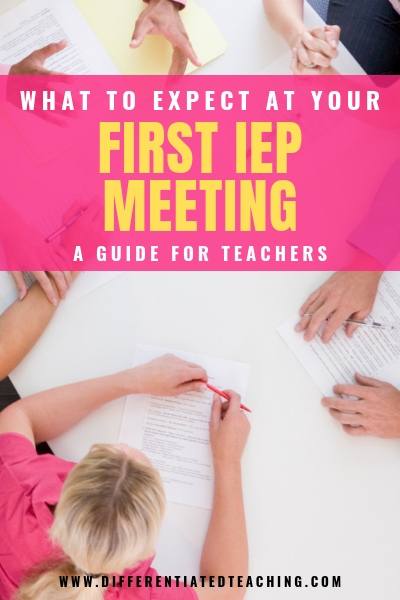A Teacher’s Guide to Universal Screening
These days almost all schools gather some type of screening data to identify which students might need additional interventions through RTI. Regardless of whether your campus uses AIMSweb, DIBELS, or one of the other available options, it can sometimes feel like these short assessments are completely useless in the grand scheme of things. I mean, how much can you really learn about a student from listening to them read for a minute?
The answer might actually surprise you! However, before we jump into that, I want to make sure to give you a clear background of what universal screening is…and is not.
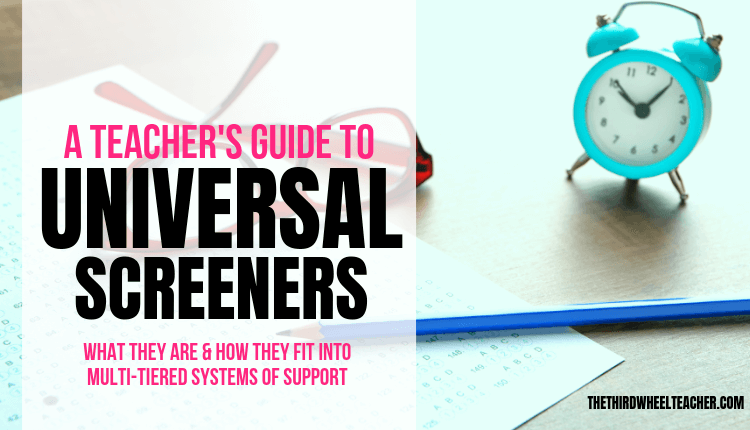
Many campuses put screening data in the hands of their MTSS team and administrators, and this data is disseminated to teachers as an afterthought. In fact, the vast majority of teachers I’ve talked to don’t actually know what to do with this data beyond a surface level.
Before we dig deep into how you can use your data, let’s start with the basics.
What is a universal screener?
A universal screener is a brief assessment that is typically administered three times per year – fall, winter, and spring.
All students on a campus participate in the screening process, including those identified as needing special education or gifted services.
The idea that all students complete the screener on grade level is important because it helps us identify how students perform compared to their peer group.
Universal screening is considered a first step in helping identify students in need of additional support.
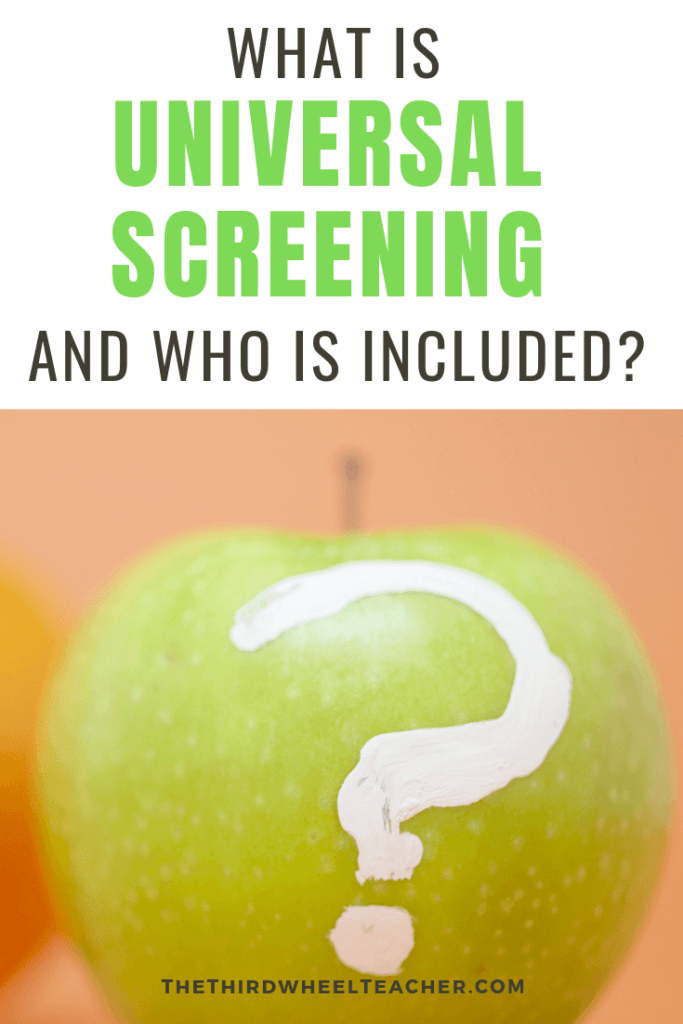
Campuses typically administer screeners in reading and math. The goal is to find students who are failing or at risk of failing to make adequate progress. However, they are available in many other areas as well.
What is the purpose of universal screening?
Universal screening is a formative assessment. It is a proactive step a campus can take to help meet their students’ needs.

Just like the hearing and vision screeners done each year, universal screeners for academics and behavior are designed to catch concerns that may impact learning while they are still in the early stages.
At the campus-level, aggregated data can help identify gaps in core Tier 1 instruction that may need to be addressed through training or purchasing new resources. The same can be true of aggregated grade-level data to a certain extent.
At the classroom-level, universal screening starts the discussion about students who may be struggling or could begin to struggle if supports aren’t provided. Low scores on the universal screener are a red flag. They indicate that it would be beneficial to look more closely at the student’s skills and progress.
Universal screening vs. diagnostic assessment
Universal screeners differ from diagnostic assessments. However, many believe them to be synonymous.
So what’s the big difference?
A universal screener is designed to help you identify WHO might need extra support. It is not designed to tell you WHAT that support should be.
Yes, there are ways that screening data can be used to help you target intervention efforts, which I’ll discuss in a future article. However, the goal of a screener isn’t to give teachers the big picture for how best to help students. This is where the diagnostic assessments come in.

Students flagged by the screener should be progress monitored for a few weeks and/or administered a diagnostic assessment. A diagnostic assessment digs deeper and helps you identify gaps in knowledge or skills.
Diagnostic assessments are typically administered one-on-one and take longer to complete because they are looking for specific areas of strength and weakness.
Many of the reading assessments given in school districts, like DRA or BAS, are diagnostic assessments. Some districts prefer to administer these to 100% of students. However, this is unnecessary and requires a great deal of time away from instruction.
A screener saves you time when used as intended. It does this by reducing the number of unnecessary diagnostic assessments you complete. While you CAN always do a diagnostic for a learner who isn’t identified, it affords you the luxury of considering the cost-to-benefit ratio. Is the instructional time taken by assessment worth the data likely to be gleaned?
What types of universal screening assessments are given for reading?
Young learners will work through several measures of early literacy. However, you’ll test the vast majority of students in two core reading skills – fluency and basic comprehension.

Reading Fluency
Typically, a one-minute timed oral reading measure assesses fluency. We commonly call this assessment R-CBM.
For the purpose of universal screening, reading fluency is looked at only as words read per minute. Many argue this is a limited view of fluency. However, it is important to remember that universal screeners are only designed to help identify where we need to dig deeper.
Reading Comprehension
Comprehension is commonly assessed via a cloze passage, where a set of choices is provided for every seventh word. You commonly see these assessments called DAZE or MAZE.
To complete this assessment, students are to select the word that makes sense in the passage. This assessment is also timed. Students work to complete as much as they can within the time limit. The entire assessment typically lasts three minutes.
One of the biggest complaints I hear from teachers about the cloze format is the simplicity. In other words, we don’t assess students on the reading skills they’ve been taught.
While this is true, it is important to remember that the goal of the universal screener is to catch students most at-risk of poor outcomes. The cloze format focuses on basic comprehension. In other words, can students follow along and comprehend a simple grade-level appropriate story?
Is there more to reading comprehension than this? ABSOLUTELY!
However, students flagged on this measure show a possible gap in the foundation of reading comprehension: the ability to read and understand.
Early Literacy Skills
Typically, we assess early learners on letter names and letter-sound fluency. They may also complete a timed decoding test using nonsense words. Some universal screeners also include segmenting and blending assessments.
Letter Sounds & Letter Naming
Assess letter-sound and letter-naming fluency using a one-minute assessment, much like reading fluency. Students name or tell the corresponding sound for each letter from a page of letters.
These assessments are important because these skills lay the groundwork for decoding. For example, students not fluent in letter sounds will likely struggle when asked to apply this knowledge to decode words.
Segmenting and blending
While some schools go bare-bones with their screening, the segmenting and blending assessments can actually be incredibly helpful. They are a great tool for identifying students who are likely to struggle.
Reading research has shown a strong link between these two early literacy skills and future issues with decoding and fluency. In fact, difficulty blending and segmenting can be an indicator that a student may have dyslexia.
Decoding nonsense words
Nonsense words assess decoding skills. Some disagree about the usefulness of assessing using nonsense words. However, this format aims to eliminate the impact of exposure and memorization so that the assessment is truly focused on decoding.
Let’s use the C-V-C word cat as an example. Maybe I have a cat or my mom reads me The Cat in the Hat at bedtime. Therefore, I’ve memorized the word and easily read it when it comes up in a text.
Regardless, students don’t have to use decoding skills to read that word. The data is skewed and shows background knowledge and experience rather than true decoding skills if there are several familiar words on a decoding assessment. Hence, the benefit of nonsense words becomes more apparent.
Other assessments
Depending on what your district uses, you might also assess initial sound fluency or even rhyme. These fall under the category of early literacy skills and can also help predict who might struggle with the transition from pre-literate to literate based on a lack of foundational skills.
What types of universal screening assessments are given in math?
Math gets a little trickier when it comes to universal screening. It is also more time intensive.
This is because there are so many discreet math skills to be assessed. While reading skills overlap and build upon one another, many math skills are separate and unrelated.
The majority of universal screeners have broken math skills down into two broad categories – computational fluency and math applications.
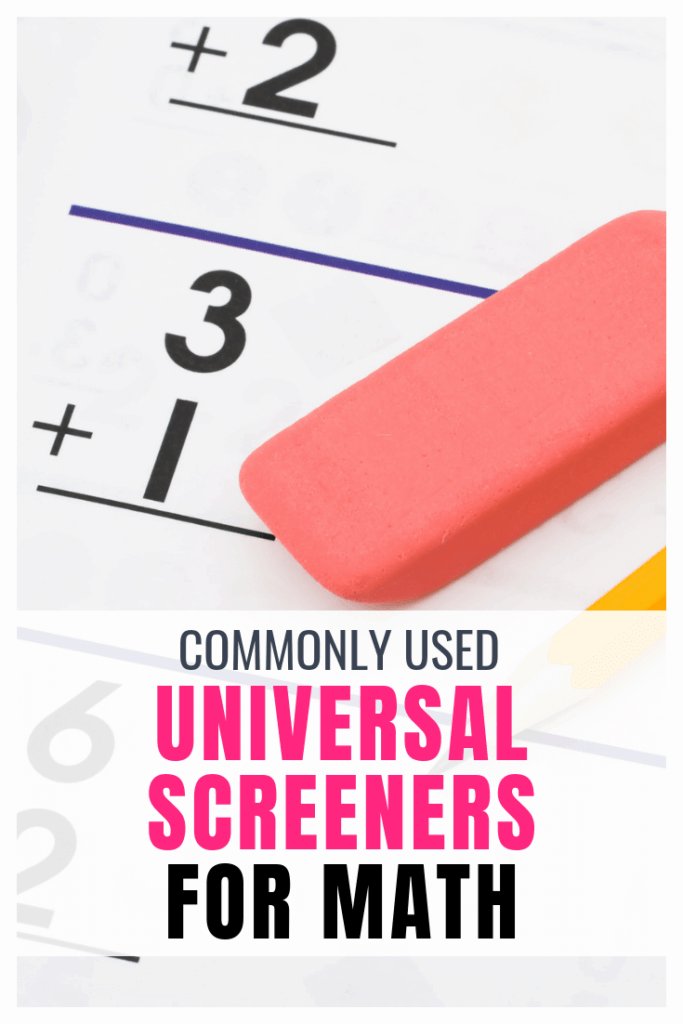
Computational Fluency
The ability to fluently add, subtract, multiply and divide is the core of the majority of elementary-level math. Therefore, it is essential that students be able to proficiently perform these calculations.
For younger students, computational fluency assessments focus on basic skills. We use timed formats to assess adding and subtracting basic facts.
As students reach third grade and beyond, we add multiplication and division.
While some will argue that timed fact assessments are invalid, the research indicates that this is a good way to determine whether students have developed automaticity with these core skills.
This is important because when a student struggles with basic computation, they have fewer mental resources left to devote to higher-level math skills and problem-solving.
Applied Math Skills
This is basically the catch-all. It is the universal screener where students will bounce around between topics solving basic problems. The first question might be measurement and reading a ruler, while the second has them breaking down numbers using place value.
Applied math skills assessments take more time than other universal screeners. However, they are timed. Students work on each problem as quickly as they can accurately do so.
While the research is less solid on the usefulness of this data, it does provide a starting point. Teachers need to know that the assessment doesn’t focus on solving word problems but instead is founded on the ability to perform basic math skills across various topics. Students struggle with word problems and multi-step math problem-solving without these foundational skills.
Other math screening measures
Just like early literacy had its own assessments, early numeracy does as well.
We commonly assess young students on several or all of these skills:
- count to 100
- identify or name numbers
- determine quantities
- compare numbers
- identify missing numbers in a sequence
Commonly used universal screening tools for reading and math
There are several commercially available universal screeners that districts can purchase. There are also free options available that you could use to gather snapshot data for your class if your district has not adopted a formal screening process for RTI.
The benefit of the paid systems is that they typically analyze the data and provide you with reports to guide the next steps. However, you could track this in a class or grade-level spreadsheet if you are doing this process with a free tool.
Commonly used paid universal screening tools:
Free* universal screening tools:
*Note that some options on the list of free screening tools above offer a paid version with report features, but you can access the tools at no cost.
Here’s a great chart from RTISuccess.org that can give you more information on these tools’ reliability, validity, and administration format.
Computerized universal screening vs. traditional paper-pencil screeners
More and more universal screening tools are transitioning from paper-pencil or teacher-administered to computer-based screening. There are advantages and disadvantages to each of these formats.
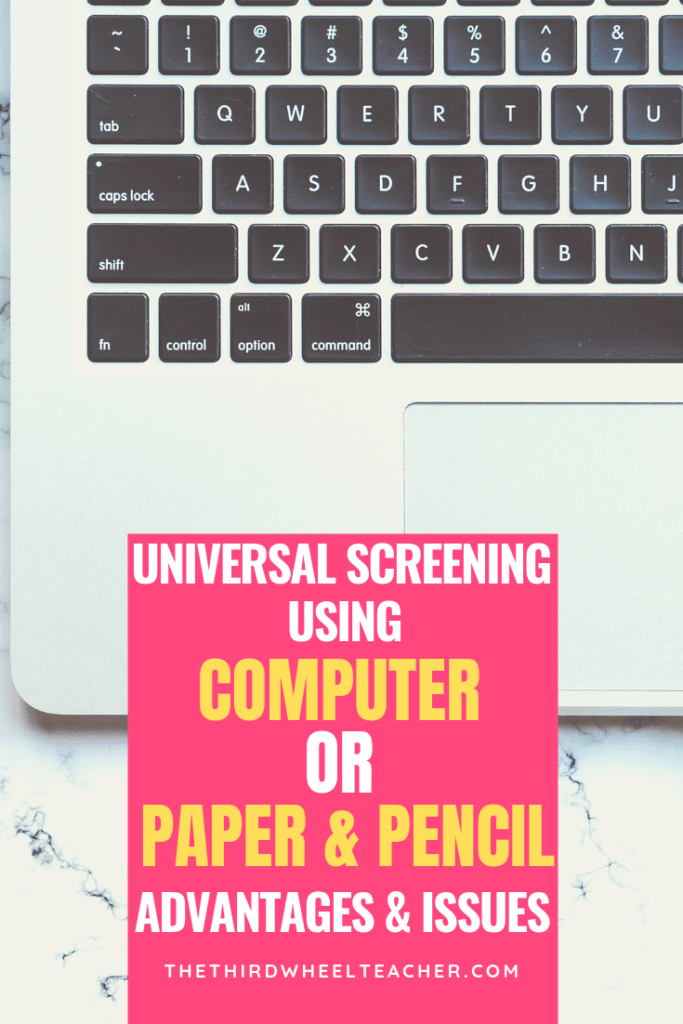
The advantage of computer-based screening is that it allows the entire group to be completed together and immediately scored, providing the teacher instant data.
Many of these assessments are also adapted so that students get more challenging questions if their performance warrants it, and they get easier questions if they are struggling. This can provide more diagnostic data than is typically available via a screening tool.
Computer technology was used to develop some screeners. However, a growing number transitioned to online formats.
The narrow sample size used to norm the data raises concerns. In other words, they are taking the scores of a small population and applying that pattern to the scores your students achieve to indicate whether your students are below, at, or above level.
While the data will grow with time, at this point, it is important to be vigilant of the size of the norm sample of any program you’re using for universal screening.
Another issue is access to technology, and the current research indicates that reading on a screen is very different than reading on paper. This means that universal screening via computer can produce different outcomes for students than if they had completed paper-based testing.
Finally, there are benefits to looking at the specific errors your students are making on screeners. I’ll discuss this further in an upcoming post.
The reality of universal screening data – the elephant in the room
The reality of universal screening is that you will get false positives and negatives. In other words, you will likely have kids that end up flagged as below-level when in fact, they are most definitely not.
Similarly, you may have students who appear to do well on these measures but are struggling in reading.

This is why the screening data is only a starting point and should never be the end of the conversation.
As professionals, it is important that we can use the data we get from universal screeners to help us best allocate our time and resources to gather more information on students.
However, our professional obligation is also to look beyond the screening data. We must offer support if we see a student struggling in the classroom.
Finding ways to utilize screening data more efficiently will make its inherent value more apparent.
Are you ready to look at the next steps after Universal Screening?
Helping students reach their potential is one of the key goals of any teacher. Whether in the classroom or working with school administrators, these posts can provide insight into research-based practices to help your students excel in the areas they need most. Click any title to find out more!



